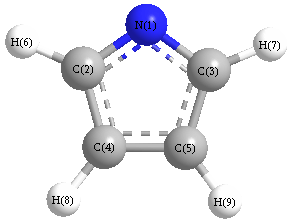Vibrational Frequencies calculated at TPSSh/3-21G*
| Mode Number |
Symmetry |
Frequency
(cm-1) |
Scaled Frequency
(cm-1) |
IR Intensities
(km mol-1) |
Raman Act
(Å4/u) |
Dep P |
Dep U |
|---|
| 1 |
A1 |
3288 |
3176 |
0.99 |
|
|
|
| 2 |
A1 |
3250 |
3139 |
6.23 |
|
|
|
| 3 |
A1 |
1533 |
1480 |
0.49 |
|
|
|
| 4 |
A1 |
1363 |
1316 |
3.57 |
|
|
|
| 5 |
A1 |
1184 |
1143 |
0.09 |
|
|
|
| 6 |
A1 |
1069 |
1032 |
20.94 |
|
|
|
| 7 |
A1 |
1018 |
983 |
17.71 |
|
|
|
| 8 |
A1 |
877 |
847 |
12.10 |
|
|
|
| 9 |
A2 |
930 |
899 |
0.00 |
|
|
|
| 10 |
A2 |
807 |
779 |
0.00 |
|
|
|
| 11 |
A2 |
490 |
473 |
0.00 |
|
|
|
| 12 |
B1 |
839 |
810 |
1.15 |
|
|
|
| 13 |
B1 |
730 |
705 |
94.49 |
|
|
|
| 14 |
B1 |
545 |
527 |
23.71 |
|
|
|
| 15 |
B2 |
3263 |
3151 |
7.70 |
|
|
|
| 16 |
B2 |
3243 |
3132 |
10.15 |
|
|
|
| 17 |
B2 |
1346 |
1300 |
39.55 |
|
|
|
| 18 |
B2 |
1293 |
1248 |
2.36 |
|
|
|
| 19 |
B2 |
994 |
960 |
15.93 |
|
|
|
| 20 |
B2 |
899 |
869 |
0.61 |
|
|
|
| 21 |
B2 |
460 |
444 |
0.70 |
|
|
|
Unscaled Zero Point Vibrational Energy (zpe) 14710.4 cm
-1
Scaled (by 0.9657) Zero Point Vibrational Energy (zpe) 14205.9 cm
-1
See section
III.C.1 List or set vibrational scaling factors
to change the scale factors used here.
See section
III.C.2
Calculate a vibrational scaling factor for a given set of molecules
to determine the least squares best scaling factor.
Charges, Dipole, Quadrupole and Polarizability
Charges from optimized geometry at TPSSh/3-21G*
Charges (e)
| Number |
Element |
Mulliken |
CHELPG |
AIM |
ESP |
| 1 |
N |
-0.499 |
|
|
|
| 2 |
C |
0.043 |
|
|
|
| 3 |
C |
0.043 |
|
|
|
| 4 |
C |
-0.251 |
|
|
|
| 5 |
C |
-0.251 |
|
|
|
| 6 |
H |
0.238 |
|
|
|
| 7 |
H |
0.238 |
|
|
|
| 8 |
H |
0.219 |
|
|
|
| 9 |
H |
0.219 |
|
|
|
Electric dipole moments
Electric dipole components in Debye
(What's a Debye? See section
VII.A.3)
| |
x |
y |
z |
Total |
| |
0.000 |
0.000 |
-2.311 |
2.311 |
| CHELPG |
|
|
|
|
| AIM |
|
|
|
|
| ESP |
|
|
|
|
Electric Quadrupole moment
Quadrupole components in D Å
Polarizabilities
Components of the polarizability tensor.
Units are
Å
3 (Angstrom cubed)
Change units.
| |
x |
y |
z |
| x |
2.046 |
0.000 |
0.000 |
| y |
0.000 |
7.866 |
0.000 |
| z |
0.000 |
0.000 |
6.366 |
<r2> (average value of r
2) Å
2
| <r2> |
83.519 |
| (<r2>)1/2 |
9.139 |
